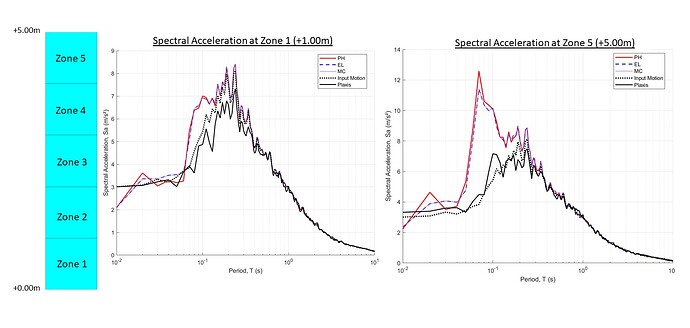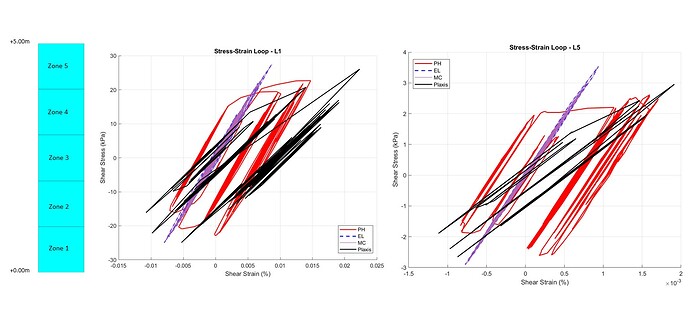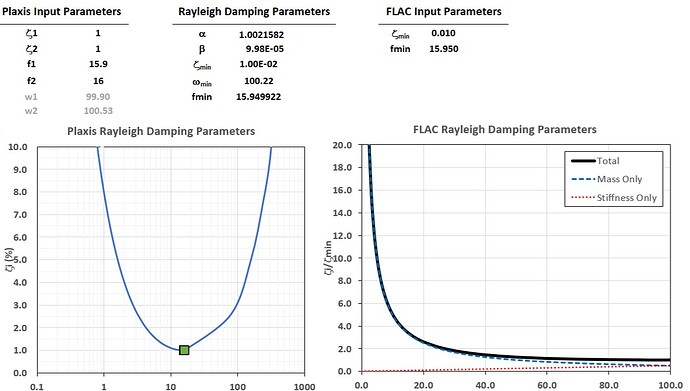Hi everyone,
I performed a zone test to compare the Plastic Hardening model in FLAC2D with the HS-Small model in Plaxis 2D. To do this, I set up a 1D single-column soil model composed of 5 zones, representing a 5-meter-deep soil deposit. In FLAC2D, I used the Plastic Hardening model, Elastic model and MC model (with hysteretic damping according to Hardin) and applied an acceleration time history at the base. I then extracted the acceleration-time records from each zone and computed the pseudo-spectral accelerations (PSA) using a Newmark-beta integration routine in MATLAB. Then I replicated the same model in Plaxis using the HS-Small model. I kept the input motion, soil parameters, boundary conditions, and Rayleigh damping properties exactly the same. From Plaxis, I obtained PSA values using both the built-in PSA output and my own MATLAB post-processing based on exported acceleration histories.
When comparing the PSA results from FLAC and Plaxis, I noticed that the FLAC Plastic Hardening model produces a distinct peak in spectral acceleration at short periods (below 0.1 seconds), which does not appear in the Plaxis results, even though the input motion and damping settings are identical.
I am wondering what might be causing this short-period spike in FLAC’s soil models. Could it be related to how the models handles very small strains, or perhaps something related to the numerical integration or internal reflections? Rayleigh damping parameters (ξ and reference frequency) are identical in both software, and I’ve attached an image showing the damping setup for reference.
Thanks for your help,
Emirhan
00_start.dat (154 Bytes)
04_MC_with_hyst.dat (3.3 KB)
03_elastic_with_hyst.dat (3.2 KB)
02_PlasticHardening.dat (5.4 KB)
01_model.dat (1.2 KB)
Matched_ACC.txt (263.7 KB)
Dear Emirhan, the first thing that you can control is the discretization of both models, as far as you are trying to compare a 1D soil column with a variable stiffness and the wave propagation could be influenced also by the discretization and not only by the boundary conditions, as you mentioned. The other thing that can be observed from the stress-strain loops, is that the soils from both models seems to have not the same stiffness, and I would suggest to you to compare first the single-element response in both softwares prior to do comparisons in terms of system response. I hope this can helps to you!
2 Likes
Hi Manuel,
Thanks a lot for your suggestions. I’ve actually been spending quite some time comparing the hardening soil models in FLAC2D and Plaxis, since I’ll be using both for my PhD. While doing that, I came across something pretty interesting. Both manuals say the model follows Hardin-type modulus reduction and damping, but there’s a difference, and it comes from Plaxis. In the HS-Small model, once the secant shear modulus reaches gamma0.7, the rest of the reduction is adjusted according to the tangent shear modulus. Plus, both the secant and tangent modulus are never allowed to drop below Gur. In FLAC’s PH model, that lower limit applies only to the tangent modulus. This little difference actually changes the modulus reduction at large strain levels, so the response shifts a bit. Because of this difference, even when I use exactly the same parameters in both models, their modulus reduction curves turn out differently. When I revised the parameters to make the reduction curves match more closely, I was able to get very similar surface responses and stress–strain loops. I’ll also take your advice on comparing the single-element responses in both software before doing more system-level comparisons that’s definitely a good idea.
1 Like


